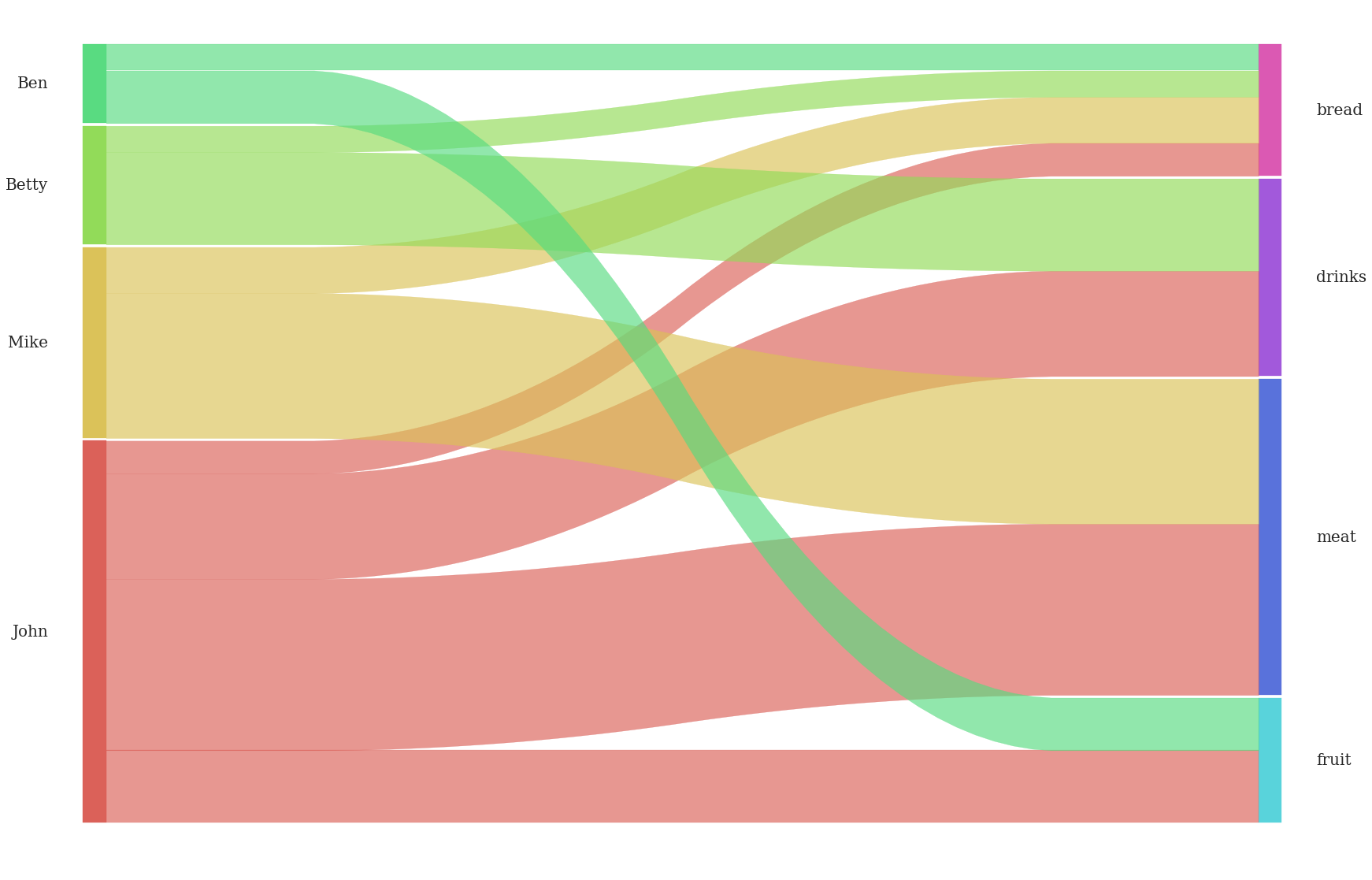Uses matplotlib to create simple Sankey diagrams flowing from left to right.
A fork of a fork of pySankey.
Requires python-tk (for python 2.7) or python3-tk (for python 3.x) install with apt-get or your package manager.
You can install the other requirements with:
pip install -r requirements.txtWith fruits.txt :
| true | predicted | |
|---|---|---|
| 0 | blueberry | orange |
| 1 | lime | orange |
| 2 | blueberry | lime |
| 3 | apple | orange |
| ... | ... | ... |
| 996 | lime | orange |
| 997 | blueberry | orange |
| 998 | orange | banana |
| 999 | apple | lime |
1000 rows × 2 columns
You can generate a sankey's diagram with this code (colorDict is optional):
import pandas as pd
import matplotlib.pyplot as plt
from pysankey import sankey
df = pd.read_csv(
'pysankey/tests/fruits.txt', sep=' ', names=['true', 'predicted']
)
colorDict = {
'apple':'#f71b1b',
'blueberry':'#1b7ef7',
'banana':'#f3f71b',
'lime':'#12e23f',
'orange':'#f78c1b',
'kiwi':'#9BD937'
}
ax = sankey(
df['true'], df['predicted'], aspect=20, colorDict=colorDict,
leftLabels=['banana','orange','blueberry','apple','lime'],
rightLabels=['orange','banana','blueberry','apple','lime','kiwi'],
fontsize=12
)
plt.show() # to display
plt.savefig('fruit.png', bbox_inches='tight') # to saveWith customer-goods.csv :
,customer,good,revenue
0,John,fruit,5.5
1,Mike,meat,11.0
2,Betty,drinks,7.0
3,Ben,fruit,4.0
4,Betty,bread,2.0
5,John,bread,2.5
6,John,drinks,8.0
7,Ben,bread,2.0
8,Mike,bread,3.5
9,John,meat,13.0
You could also weight:
import pandas as pd
import matplotlib.pyplot as plt
from pysankey import sankey
df = pd.read_csv(
'pysankey/tests/customers-goods.csv', sep=',',
names=['id', 'customer', 'good', 'revenue']
)
weight = df['revenue'].values[1:].astype(float)
ax = sankey(
left=df['customer'].values[1:], right=df['good'].values[1:],
rightWeight=weight, leftWeight=weight, aspect=20, fontsize=20
)
plt.show() # to display
plt.savefig('customers-goods.png', bbox_inches='tight') # to saveSimilar to seaborn, you can pass a matplotlib Axes to sankey function with the keyword ax=:
import pandas as pd
import matplotlib.pyplot as plt
from pysankey import sankey
df = pd.read_csv(
'pysankey/tests/fruits.txt',
sep=' ', names=['true', 'predicted']
)
colorDict = {
'apple': '#f71b1b',
'blueberry': '#1b7ef7',
'banana': '#f3f71b',
'lime': '#12e23f',
'orange': '#f78c1b'
}
ax1 = plt.axes()
ax1 = sankey(
df['true'], df['predicted'], aspect=20, colorDict=colorDict,
fontsize=12, ax=ax1
)
plt.show()Use of figureName, closePlot and figSize in sankey() has been removed.
This is done so matplotlib is used more transparently as this [issue] suggested (anazalea#26 (comment)) on the original github repo.
Now, sankey() does less of the customization and let the user do it to their liking by returning a matplotlib Axes object, which mean the user also has access to the Figure to customise.
Then they can choose what to do with it - showing it, saving it with much more flexibility.
- To save a figure, after
sankey(), one can simply do:
plt.savefig("<figureName>.png", bbox_inches="tight", dpi=150)-
To display the diagram, simply do
plt.show()aftersankey(). -
You can modify the sankey size by changing the one from the matplotlib figure.
plt.gcf().set_size_inches(figSize)
-
It is possible to modify the diagram font looks, for example, add the following lines before calling
sankey():plt.rc("text", usetex=False) plt.rc("font", family="serif")
pylint pysankey
python -m unittest
coverage run -m unittest
coverage html
# Open htmlcov/index.html in a navigator


